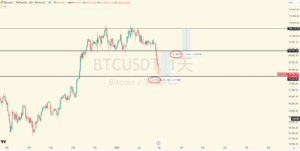A Global Crypto Market Quake
On February 28, 2025, Bitcoin’s price dropped from $94,000 a week ago to $87,000, a decline of 10% within 24 hours, marking its largest single-day drop since mid-January. This sharp downturn quickly spread throughout the entire cryptocurrency market. This crash is not an isolated event. Since Bitcoin hit $104,000 in December 2024, it has been fluctuating between $100,000, forming a double-top structure (as mentioned in the previous article). Recently, multiple negative factors emerged, culminating in Bitcoin’s downward trend, breaking the $80,000 support level.

Three Driving Factors Behind the Crash
-
Policy and Macroeconomic Pressures
- Fed’s Hawkish Turn: Increased expectations of interest rate hikes have strengthened the US dollar index, putting pressure on risk assets. The growing correlation between cryptocurrency and traditional financial markets has led to a pullback from high-risk areas.
- State-Level Legislative Setbacks: South Dakota postponed the HB1202 bill allowing state-level Bitcoin investments, and Montana rejected the Bitcoin reserve asset plan, weakening institutional confidence.
- Tighter Global Regulations: Countries like Turkey and India have strengthened cryptocurrency trading restrictions, and the European Union has added exchanges to the list of sanctions against Russia, increasing market concerns over liquidity.
-
Structural Risks in the Market
- Coinbase Executives Cashing Out: Coinbase executives cashed out $4.6 billion in February. Meanwhile, Mt. Gox exchange started a $9 billion Bitcoin compensation plan, triggering panic over oversupply.
- Leverage Amplifies Volatility: With contract leverage over 50x, price fluctuations were magnified, and the crash triggered a chain reaction of liquidations, forming a vicious cycle of “price drop → liquidation → accelerating decline.”
-
Geopolitical and Technological Shocks
- Trump’s Tariff Policy: Expectations of an escalation in tariffs on Chinese tech products led to a decline in both US tech stocks and cryptocurrencies.
- Security Breaches: Bybit exchange suffered a hack with a loss of $1.5 billion, and Infini platform lost $50 million in assets, exposing industry security risks.
Market Impact and Key Indicators to Watch
-
Short-term Technical and Sentiment Recovery
Bitcoin has now fallen to the key support level of $78,000, as mentioned in the previous article. If this support cannot hold, it may drop further to the $73,000 level. The next key level in the mid-term is $50,000. If the $73,000 support is breached, Bitcoin may further challenge the strong support at $50,000. According to AIcoin , the US Bitcoin spot ETF has seen $2.708 billion in net outflows over four consecutive days, indicating increased institutional risk aversion, but a return of funds could alleviate selling pressure. -
Medium to Long-term Variables and Potential Opportunities
- Policy Dynamics: If Trump’s “pro-crypto” policies come into effect, they may help stimulate market recovery.
- Technical Cycles: The supply tightening effect of Bitcoin’s 2024 halving has not fully manifested, and historical data shows an average price increase of 40% post-halving.
- Industry Regulation: Traditional financial institutions like JPMorgan are accelerating their custody services, and Bitcoin miners’ carbon-neutral transformations may attract ESG funds.
Investor Caution Regarding Liquidity Crisis
-
Short-term Risk Control:
Avoid high-leverage contracts and prioritize spot trading or low-leverage positions (recommended no higher than 5x). Focus on on-chain data (e.g., ETF net outflows). -
Long-term Investment Direction:
Focus on targets with clear regulatory progress, such as Bitcoin spot ETFs and regulated exchange platform tokens. Be cautious of liquidity risks in small and mid-cap tokens, and prioritize cryptocurrencies within the top 20 by market cap. Users can also explore quality projects on JuCoin Labs .
Market Insights: Survival Strategies Amidst Volatility
This crash further reinforces the cyclical nature of the cryptocurrency market. Despite Bitcoin often being compared to “digital gold,” its price is still driven by multiple factors, including macroeconomic conditions, regulatory policies, and market sentiment. For ordinary investors, building risk awareness, diversifying portfolios, and focusing on the evolution of underlying technologies (such as Layer 2 scaling solutions) are more important than short-term price speculation.
As Matrixport analyzed on February 25: “The short-term pain in the market will not alter the long-term value of blockchain technology, but participants must learn to identify real opportunities and traps in the volatility.”



